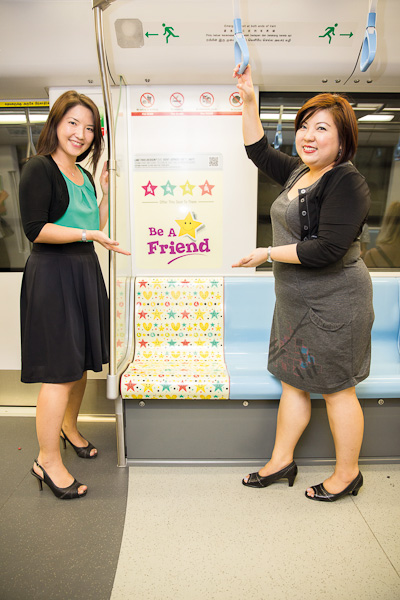Chope A Seat With Cheer

What are some things that bug people most when they are on the train? According to a “root cause” study done by the Land Transport Authority (LTA) and the Singapore Kindness Movement in 2013, one of them is when reserved seats are hogged by the undeserving.
The six-month long study, which involved 1,000 commuters, showed that passenger behaviour substantially affects commuters’ travel experience. When asked how their ride could be improved, many commuters suggested enlarging the Reserved Seat signs. Their feedback showed that visual cues could influence people’s actions.
Interestingly, the study also showed that commuters tend to look for existing queues to join at the train platforms, suggesting a desire to follow social norms.
These insights and past experience led the team to embark on an unusual makeover for the reserved seats.
Instead of simply enlarging the Reserved Seat signs, the team used an assortment of positive phrases like “Show you care” and “Be sweet” to nudge passengers to do the right thing. Studies show that positive reinforcement works better than shaming or poking fun at those who break the norm, pointed out team leader Ms Tammie Loke, LTA’s Group Director for Corporate Communications.



Four seat designs were made to appeal to various groups. For example, the “Be A Friend” pattern uses star symbols familiar to young children. Each turned out to be equally popular in a voting exercise with the public.
Then, the team hypothesised that “flamboyant” patterns and colours would signal clearly that the seats are meant for those who need them more, added Ms Loke.
Ms Michelle Ang, LTA’s Deputy Manager for Publicity and Promotions, added: “The intention is to make [commuters] think twice before taking those seats. People will be more conscious if they sit on a seat that’s different from the rest.” To find suitably eye-catching prints, the team visited fabric shops and even considered gift-wrap patterns.
Two months after installing the colourful seats on Downtown Line trains, the team conducted a straw poll among more than 200 commuters. Eight in 10 agreed that the colourful seats are effective in reminding commuters to give up their seats. LTA will monitor these cheery seats’ effectiveness for a year before introducing them to other train lines.
“Commuter behaviour is powerful in making for a better daily commute,” said Ms Loke. But the team knows that changing behaviour will take time. “Our goal is to make commuters more aware by ‘nudging’ them towards more consideration for each other… [and] putting a smile on everyone’s face.”
Observing Social Norms
In 2012, the LTA team observed the queuing culture at Bishan MRT and posted a video of the lines on social media. Commuters then pointed out queues at other stations. That prompted the LTA to share “sequel” videos of the queues at the other station platforms, which they say has led to commuters queuing up at stations throughout Singapore. The Downtown Line stations also have modified queue lines to guide where commuters should stand.
- POSTED ON
May 15, 2014
- TEXT BY
Siti Maziah Masramli
- PHOTOS BY
Norman Ng









